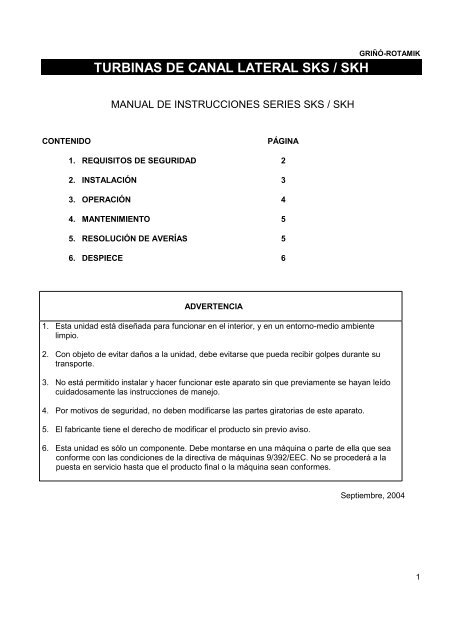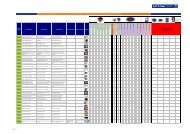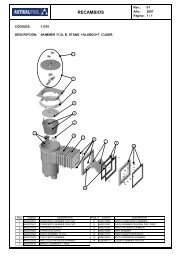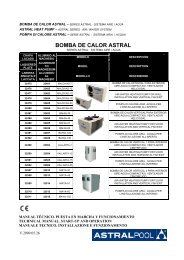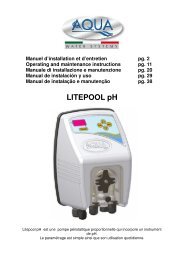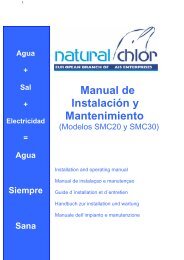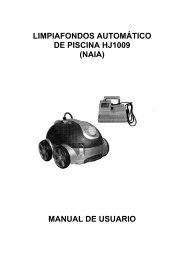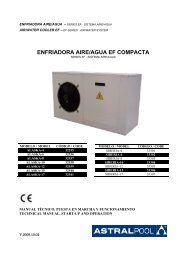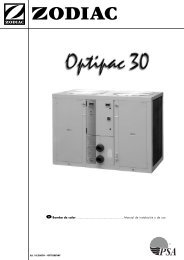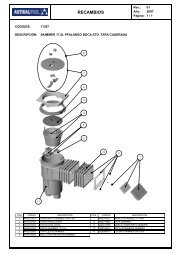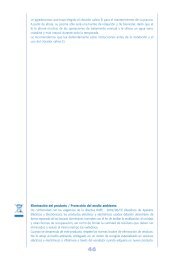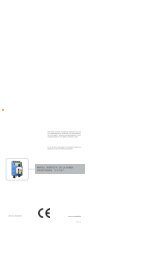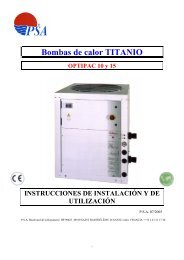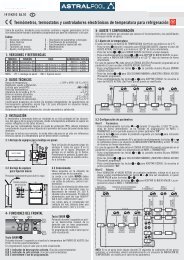TURBINAS DE CANAL LATERAL SKS / SKH - Ferromar
TURBINAS DE CANAL LATERAL SKS / SKH - Ferromar
TURBINAS DE CANAL LATERAL SKS / SKH - Ferromar
Create successful ePaper yourself
Turn your PDF publications into a flip-book with our unique Google optimized e-Paper software.
<strong>TURBINAS</strong> <strong>DE</strong> <strong>CANAL</strong> <strong>LATERAL</strong> <strong>SKS</strong> / <strong>SKH</strong>GRIÑÓ-ROTAMIKMANUAL <strong>DE</strong> INSTRUCCIONES SERIES <strong>SKS</strong> / <strong>SKH</strong>CONTENIDOPÁGINA1. REQUISITOS <strong>DE</strong> SEGURIDAD 22. INSTALACIÓN 33. OPERACIÓN 44. MANTENIMIENTO 55. RESOLUCIÓN <strong>DE</strong> AVERÍAS 56. <strong>DE</strong>SPIECE 6ADVERTENCIA1. Esta unidad está diseñada para funcionar en el interior, y en un entorno-medio ambientelimpio.2. Con objeto de evitar daños a la unidad, debe evitarse que pueda recibir golpes durante sutransporte.3. No está permitido instalar y hacer funcionar este aparato sin que previamente se hayan leídocuidadosamente las instrucciones de manejo.4. Por motivos de seguridad, no deben modificarse las partes giratorias de este aparato.5. El fabricante tiene el derecho de modificar el producto sin previo aviso.6. Esta unidad es sólo un componente. Debe montarse en una máquina o parte de ella que seaconforme con las condiciones de la directiva de máquinas 9/392/EEC. No se procederá a lapuesta en servicio hasta que el producto final o la máquina sean conformes.Septiembre, 20041
2. InstalaciónGRIÑÓ-ROTAMIK2.1) Aplicación:2.1.1) Las Turbinas de Canal Lateral se utilizan para manejar aire y gases incombustibles, nocorrosivos ni explosivos. La temperatura ambiente o del gas no debe exceder de 40º C.2.1.2) Han de filtrarse el polvo y las partículas sólidas antes de que lleguen al conducto deadmisión del dispositivo.2.1.3) Estos dispositivos están diseñados para un funcionamiento continuo. En caso defuncionamiento discontinuo o de temperatura ambiente elevada, comprobar la idoneidad(temperatura máxima admisible) consultando a los representantes del fabricante.2.1.4) La presión admisible para el funcionamiento se muestra en catálogo de característicastécnicas2.1.5) Estos dispositivos no se han de hacer funcionar con el conducto de admisión o de salidatapados o de diámetros no adecuados.2.2) Instalación:2.2.1) Las Turbinas de Canal Lateral pueden montarse en cualquier sentido, pero cuando semonten verticalmente, el lado correspondiente al motor debe quedar hacia arriba.2.2.2) Para evitar la vibración, la unidad ha de montarse sobre una superficie segura.2.2.3) Con el fin de asegurar un enfriamiento perfecto, las distancias mínimas entre la cubiertafrontal o la cubierta y las paredes deben ser de 20 mm. Hay que asegurar, sin embargo,que no se produzcan obstrucciones en el sistema de circulación del aire de enfriamiento.2.2.4) Mantener apartados de la unidad los materiales inflamables.2.2.5) El aire y los gases deben filtrarse, antes de que entren en la admisión, a través de unconducto de admisión o de un filtro en línea.2.2.6) Para reducir el ruido, pueden incorporarse silenciadores opcionales.2.3) Conexión eléctrica:ADVERTENCIA: No se permite la realización de ningún tipo de trabajo en la unidadsin desconectar previamente la alimentación eléctrica.2.3.1) La tensión de alimentación eléctrica debe ser la misma que la especificada en la placade características.2.3.2) Los conductores eléctricos han de conectarse de acuerdo con el diagrama fijado enla caja de terminales.2.3.3) El conductor de protección de tierra ha de conectarse al terminal de puesta a tierra.2.3.4) Deben seleccionarse los disyuntores de circuito de forma que sean adecuados a losregímenes de corriente de los motores.3
3. Operación:GRIÑÓ-ROTAMIK3.1) El sentido de rotación de estos dispositivos ha de ser el indicado por el sentido de laflecha marcada en la carcasa.3.2) Para el funcionamiento con alimentación trifásica, el cambio de sentido del giro puedeconseguirse intercambiando cualquiera de las dos líneas de la tensión de entrada.3.3) Estos dispositivos deben hacerse funcionar con el caudal de aire y la presión que seindican dentro de los márgenes permitidos en la Tabla 1.3.4) Con objeto de evitar el funcionamiento fuera del margen permitido, se recomiendaincorporar una válvula limitadora de seguridad para presión y/o vacío.4
4. Mantenimiento:GRIÑÓ-ROTAMIK4.1) Para conservar unas buenas condiciones de enfriamiento, es necesario limpiar el interiory el exterior de la cubierta del ventilador con el fin de eliminar la suciedad y el polvo deforma periódica, ya que de no hacerlo, el motor podría quemarse.4.2) El cojinete, retén de aceite y silenciadores están sometidos a desgaste. Cuando seanecesario, estas piezas deberán reemplazarse por otras nuevas.5. Resolución de averías:Avería Causa Solución. No hay alimentación eléctrica.. Dos conductores dealimentación eléctrica abiertos.. Interruptor de alimentación oarrancador abiertos.. Devanado del motor abierto.. Protector o circuito de protecciónabiertos.circuito de protección.El motor no gira y no se percibezumbidoEl motor no gira y se percibezumbido. Un conductor de alimentacióneléctrica abierto.. Interruptor de alimentación oarrancador abiertos.. Devanado del motor abierto.. Cojinete defectuoso.. Rotor bloqueado por materialextraño.. Rotor bloqueado contra lacarcasa o la cubierta.. Condensador (conexiónmonofásica) defectuoso.. Aplicar alimentación eléctrica.. Comprobar el cable dealimentación.. Cambiar el interruptor dealimentación o el arrancador.. Cambiar el devanado del motor.. Cambiar el protector o reparar el. Comprobar el cable dealimentación.. Cambiar el interruptor dealimentación o el arrancador.. Cambiar el devanado del motor.. Cambiar el cojinete.. Limpiar el rotor.. Ajustar el rotor.. Cambiar el condensador.Giro normal del motor. El protectorcontra sobrecalentamiento o elcircuito de protección se activanrepetidamenteVacío insuficienteRuido anormal. Motor sobrecargado.. Cortocircuito en el devanado.. Rotor con obstrucciones.. Compresor demasiado pequeño.. Frecuencia de la alimentacióneléctrica incorrecta.. Sentido de rotación errónea.. Retén de aceite defectuoso.. Fugas de aire en el sistema.. Silenciador sucio.. Cojinete defectuoso.. Disminuir la presión operativa,limpiar el filtro, cubierta delventilador, silenciador oconductor.. Cambiar el devanado del motor.. Limpiar o ajustar el rotor.. Cambiar a un compresor mayor.. Pasar a una frecuencia dealimentación eléctrica adecuada.. Cambiar el sentido.. Cambiar el retén de aceite.. Comprobar el sistema yhermetizarlo.. Limpiar el silenciador.. Engrasar el cojinete o cambiarlo.5
<strong>DE</strong>SPIECE <strong>SKS</strong>-<strong>SKH</strong> / EXPLO<strong>DE</strong>D VIEW <strong>SKS</strong>-<strong>SKH</strong>GRIÑÓ-ROTAMIKSiimplle ettapaDoblle ettapa6
GRIÑÓ-ROTAMIKSI<strong>DE</strong> CHANEL BLOWERS <strong>SKS</strong> - <strong>SKH</strong>INSTRUCTION MANUALCONTENTPAGE1. SAFETY REQUERIMENT 82. INSTALLATION 93. OPERATION 104. MAINTENANCE 105. TROBULE-SHOOTING 116. EXPLO<strong>DE</strong>D VIEW 12WARNING1. This unit is designed to operate indoors, and is an enviroment that is a water-free anddust-free.2.- To avoid damaging this device, it must be absolutely prevented from dropping duringtransportation.3.- It’s not allowed to install and operate this device before reading the instructionthoroughly.4.- For safety reason, please don’t modify or repair the rotating part of this device.5.- The manufacturer has the right to modify the product without notice.6.- This unit is only a component, it must be installed in a machine or part of a machinewhich meets the terms of the machine directive 9/392/ECC. Commission will not occur untilthe end product or machinery conforms with the EN60204-1.September, 20047
1. Safety requirements:GRIÑÓ-ROTAMIK1.1) All the works of transportation, installation, maintenance and troubleshooting must beexecuted by a responsible, qualified personnel.1.2) This device must be set up according to this instruction manual.1.3) The grounding wire must be connected well accordingly.1.4) The lead wires as a conductor to the power supply should be properly sized and havestrain relief to the wires at the connection terminals. If this is failed, electric shock and firewill be possible.1.5) While rotating, human body must keep away from the rotating portion such as the CoolingFan and do no reach into the device through the intake or outlet.1.6) Once the power electricity was interrupted, the power switch must be turned offimmediately.1.7) If the device couldn’t accelerate up to its rated speed in 15 seconds from the power switchturned on, please turn off the power immediately and check it carefully.1.8) The power supply must be turned off before moving, maintaining, or repairing this device.Please note that, due to rotating inertia, the device may continue to run several minutesafter power turned off.1.9) These devices are only used to handle or conveying dust free air, non-combustible, noncorrosiveand non-explosive gases, vapors or liquids.1.10) The intake must be properly sited and covered so that no dirt or solid particles can besucked in.1.11) When the device is operated at impermissible high pressure condition, a suitablepressure-relief valve must be used to prevent overheating of motor.1.12) The End Cover is used to prevent contact and direct the cooling air flow, can not beremoved; otherwise the motor will get overheating.8
2. InstallationGRIÑÓ-ROTAMIK2.1) Application:2.1.1) The Side Channel Blowers are used to handle non-combustible, non-corrosive and nonexplosivegases and air. The ambient or gas temperature should be less than 40ºC.2.1.2) Dirt and solid particle must be filtered before entering intake of the device.2.1.3) These devices are designed for continuous operation, in case of non-continuous running orhigh ambient temperature, checking suitability (maximum permissible temperature) with therepresentatives of manufacturer.2.1.4) The permissible pressure for operation is shown in the general catalogue2.1.5) These devices must not be operated with closed intake or outlet.2.2) Installation:2.2.1) The Side Channel Blowers can be installed in any direction, but when mounted vertically, themotor side should be upward.2.2.2) To avoid vibration, the unit must be mounted on a rigid base.2.2.3) To ensure perfect cooling, the minimum clearances between the Front Cover or Cover andthe walls should be 20mm. Make sure too, no obstructions in the cooling air flow system.2.2.4) Any flammable materials must be kept away from the unit.2.2.5) Air and gases should be filtered before entering the intake by an intake or inline filter.2.2.6) To reduce noise, additional silencers are optional.2.3) Electrical Connection:WARNING: No any connecting work is allowed before the electrical powerdisconnected.2.3.1) The supplied power voltage must be the same as the rating stated on the name plate.2.3.2) The lead wires must be connected according to the diagram attached on the terminal box.2.3.3) The protective earth conductor must be connected to the grounding terminal.2.3.4) Select correct circuit breakers to the current rating of motors.9
3. Operation:GRIÑÓ-ROTAMIK3.1) These devices must be rotated in the “Arrow” direction marked on the casing.3.2) For three phase, changing direction may be done by exchanging any two of the lines ofpower input.3.3) These devices should be operated with the air flow and pressure within the permitted rangelisted in the Table 1.3.4) To avoid operating over the permitted range, the pressure or vacuum relief isrecommended.4. Maintenance:1) To maintain a good cooling performance, it’s necessary to clean the inside and outside of thefan Cover to remove dirt and dust in a period of time; otherwise the motor might be burnt.2) The bearing, oil seal and silencers are subject to wear, these parts should be replaced with newones as necessary.10
5. Trouble-shooting:GRIÑÓ-ROTAMIKFault Cause Remedy. No power.. Two power cords opened.. Power switch or stator defected.. Motor winding opened.. Protector or protecting circuitopened.Motor does not run and withouthumming noiseMotor does not run with hummingnoise. One power cord opened.. Power switch or stator defected.. Motor winding opened.. Bearing defected.. Impeller jammed by foreignmaterial.. Impeller jammed against casingor cover.. Capacitor (single phase)defected.. Supply power.. Check the power cord.. Change the power switch orstator.. Change the motor winding.. Change the protector or fix theprotecting circuit.. Check the power cord.. Change the power switch orstator.. Change a new motor winding.. Change bearing.. Clean the impeller.. Adjust the impeller.. Change a new capacitor.Normal running, over heating,protector or protection circuit tripsrepeatedlyWeak vacuumAbnormal noise. Motor overloaded.. Short-circuit in the winding.. Impeller jammed.. Compressor too small.. Wrong power frequency.. Wrong direction of rotation.. Oil seal defected.. Air leakage in the system.. Silencer dirty.. Bearing defected.. Reduce operating pressure, cleanfilter, fan cover, silencer or pipes.. Change a new motor winding.. Clean or adjust the impeller.. Change a larger compressor.. Adjust power frequency.. Change direction.. Change a new oil seal.. Check the system and make airtight.. Clean silencer.. Regrease bearing or change anew bearing.11
<strong>DE</strong>SPIECE <strong>SKS</strong>-<strong>SKH</strong> / EXPLO<strong>DE</strong>D VIEW <strong>SKS</strong>-<strong>SKH</strong>GRIÑÓ-ROTAMIKSiimplle ettapaDoblle ettapa12
GRIÑÓ-ROTAMIKGRIÑÓ-ROTAMIKc./ Londres, 7 - Polígono Industrial Cova Solera08191 RUBÍ (Barcelona- Spain)Tel. 34-(93) 588 06 60 - Fax. 34-(93) 588 07 48web: grino-rotamik.ese-mail: grino-rotamik@grino-rotamik.es13


